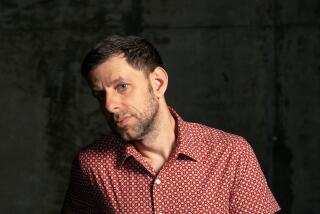OPERA REVIEW : ‘Der Fliegende Hollander’ Walks Gangplank at the Met
- Share via
NEW YORK — The program at the Metropolitan Opera on Monday claimed that August Everding’s lavish new production of “Der Fliegende Hollander” took place as usual “in the 1770s.”
Don’t you believe it. This wasn’t Wagnerian business as usual.
The legendary Flying Dutchman apparently roamed the seas on a huge ocean liner. In place of the blood-red sails described in the text, we saw a blood-red anchor dangling from the steel prow. The anguished protagonist made his entrance singing “Die Frist ist um” from a suspended gangplank.
Senta, the obsessive heroine, and her friends didn’t do much spinning. In fact, they couldn’t do any spinning.
The score still meticulously describes that quaint and busy activity, but most of the women sat under electric lights in some sort of factory and mended miles of fabric by hand. A couple of choristers actually operated sewing machines.
The only wheel to be found on the stage propelled the chair that, for reasons unexplained, accommodated Frau Mary. “Ich spinne fort,” the old nurse muttered on cue, disdaining Senta’s dream--”I’ll go on spinning.” Then she dutifully picked up her needlepoint.
I know. I know. Details. . . .
Unfortunately, they were crucial, symptomatic details. They tried to make the opera look modern, but ended up making it look silly.
Everding, normally regarded as a knowing conservative in matters of operatic reinterpretation, decided to contradict the letter of the libretto. Although the practice is dangerous, it sometimes can illuminate an inspired vision. There would seem to be little inspiration here, alas, just knee-jerk trendiness.
Everding obviously savored the bleakness of Hans Schavernoch’s sets. Looming icebergs, frosty vistas, wind-swept skies and violent snows threaten the sterile milieu of the industrial bourgeoisie. It is all very picturesque, not very relevant.
Given Lore Haas’ Ibsenesque costumes, Everding dressed the characters in affecting cliches of contemporary alienation. The basic action scheme, however, adhered stubbornly to operatic banalities.
What we have here is a crisis of stylistic credibility.
All might not have been lost had the Met been able to deal in musical redemption. The sonic strengths, unfortunately, could not outweigh the dramatic weaknesses.
Although James Levine enforced his customary orchestral brilliance in the pit, the wonted grandeur was achieved without an abiding sense of urgency. His tempos tended toward the sluggish, and rhythmic momentum turned out to be a sometime thing.
The conductor opted for the cumulative tensions of Wagner’s original one-act version. Then he compromised that wise decision by coming to a full stop for the concert ending of the overture, possibly in quest of automatic applause.
The nearly all-American cast proved generally competent. By current standards in Wagner, that can be deemed a compliment.
James Morris attempted to imbue the title role with bel-canto values. It was a rare and admirable effort. He lacked the incisive force of a bona fide Heldenbariton, however, and the dominating, brooding heroism of the character seemed to elude him.
Mechthild Gessendorf mustered a lot of strenuous swooping and flatting in the cruel climactic phrases of Senta, and often confused banal poses with acting. She was serving, not incidentally, as an early replacement for the recalcitrant Eva Marton.
Paul Plishka’s sturdy basso sounded tired in the bluff platitudes of Daland. Gary Lakes, like many an Erik before him, found the fusion of Italianate cantilena and Germanic bluster discomforting. Robert Gambill introduced an agile figure and a fragile tenorino as the Steersman. Replacing Gweneth Bean, the ubiquitous Judith Christin contributed a theatrically giddy, vocally lightweight Frau Mary.
The Met audience, which paid up to $105 for the privilege, cheered as if it had returned to the golden age of song. Apparently New York does not remember George London and Leonie Rysanek or Hans Hotter and Astrid Varnay, much less Friedrich Schorr and Kirsten Flagstad.
More to Read
The biggest entertainment stories
Get our big stories about Hollywood, film, television, music, arts, culture and more right in your inbox as soon as they publish.
You may occasionally receive promotional content from the Los Angeles Times.










